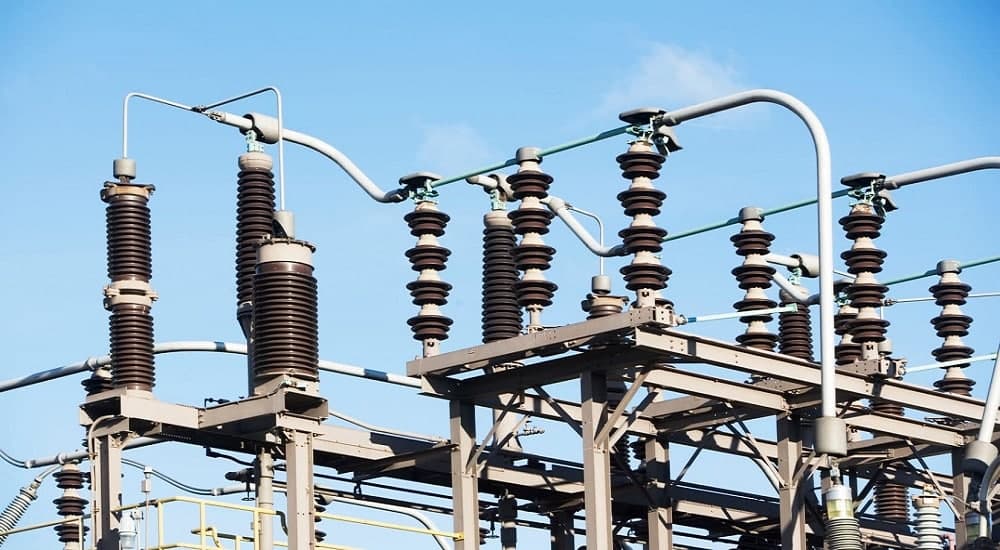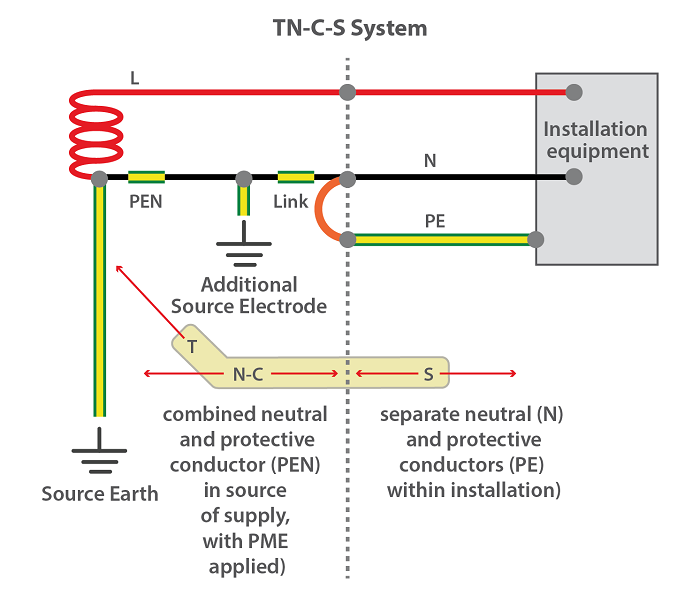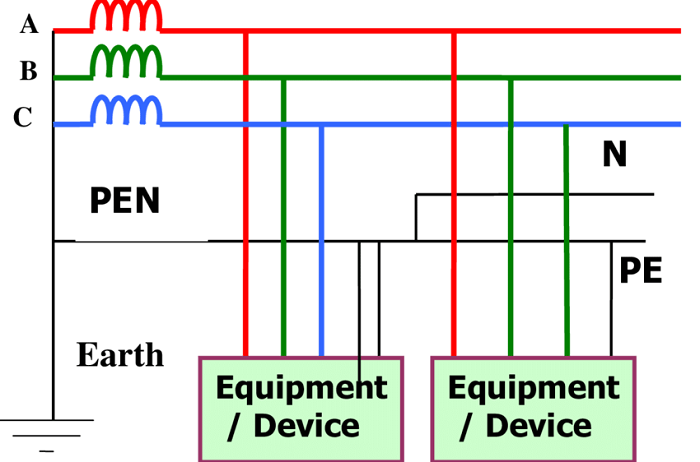Earthing is the connection of the neutral point of a power supply system to the earth. The primary purpose of earthing is to avoid or minimize the danger of electrocution, fire due to earth leakage of current through the undesired path and to ensure that the potential of a current-carrying conductor does not rise concerning the earth than its designed insulation. As you may know, there are five types of earthing systems. In this article, we will discuss the TNCS earthing system. Read this new blog in Linquip to find out more.
In TNCS systems, within the supply cable, the neutral and earth wires are linked. This is usually a circular cable, with the line as the center core and a ring of wires around it providing the neutral and ground. The Neutral and Earth are divided at the property, with the Earth terminal normally on the side of the cutout. The earth and neutral are joined inside the cutout. Several suppliers and companies, as well as various Manufacturers and Distributors, provide various types of TNCS earthing systems, and there are several types of TNCS Earthing Systems for Sale on Linquip.
There is a comprehensive list of TNCS earthing system services on the Linquip website that covers all factory operations. Linquip vendors can assist you with this. Please contact TNCS Earthing Systems Experts in Linquip to learn more about how to connect with a diverse group of service providers who consistently deliver high-quality products.
TNCS earthing system features
For the temporary power supply of the TN-CS system, if the front part is powered by the TN-C method, and the construction code specifies that the construction site must use the TN-S power supply system, the total distribution box can be divided at the rear part of the system. Out of the PE line, the features of the TNC-S system are as follows.
- Working zero line N is connected with the special protection line PE. When the unbalanced current of the line is large, the zero protection of the electrical equipment is affected by the zero line potential. The TN-C-S system can reduce the voltage of the motor housing to the ground, but it cannot eliminate this voltage. The magnitude of this voltage depends on the load imbalance of the wiring and the length of this line. The more unbalanced the load and the longer the wiring, the greater the voltage offset of the device housing to the ground. Therefore, it is required that the load unbalances current should not be too large and that the PE line should be grounded repeatedly.
- The PE line cannot enter the leakage protector under any circumstances, because the leakage protector at the end of the line will cause the front leakage protector to trip and cause a large-scale power failure.
- Besides, the PE line must be connected to the N line in the general box, the N line and the PE line must not be connected in other compartments. No switches and fuses shall be installed on the PE line, and no earth shall be used as the PE line.

Through the above analysis, the TNCS earthing system is temporarily modified on the TNC system. When the three-phase power transformer is in good working ground condition and the three-phase load is relatively balanced, the effect of the TNCS system in construction electricity use is still feasible. However, in the case of unbalanced three-phase loads and a dedicated power transformer on the construction site, the TNS earthing system must be used.
TNCS earthing system diagram
The Neutral and Earth wires are combined within the supply cable. Typically this will be a concentric cable, with the line as the central core, and a ring of wires around this for the combined neutral and earth.
At the property, the Neutral and Earth are separated, with the earth terminal usually being on the side of the cutout. Inside the cutout, the earth and neutral are linked.
Throughout the supply network, the combined earth/neutral conductor is connected to the ground in multiple places, either buried underground or at the poles for overhead supplies. This multiple earthing is why a TNCS supply is often called PME (Protective Multiple Earthing).
The system diagram is shown in the figure below.
The differences between the TNS and TNCS earthing system
The major difference between these two methods of earthing is that you have a separate earth core back to the substation in a TNS whereas in a TNCS the earth and neutral are the same core (CNE). This means that if this was to break then all your metalwork can become live at mains potential, hence it has to be tied down using electrodes along its length to minimize the risk (Protective multiple earthing).
TNCS is also cheaper than the TNS method for the DNO (Distribution Network Operator).
Besides, in the event of a fault, the current flowing in the customer’s earthing conductors can be much greater than for a TNS system.
Advantages of the TNCS Earthing System
The advantages of the TNCS earthing method are as follows.
- This earthing method is very cost-effective since a two-core cable is cheaper than a 3-core one.
- As the outer sheath in the TNCS earthing method is usually plastic, there is no problem with corrosion.
- There is no overvoltage stress on equipment insulation.
- TNCS method has a lower earthing resistance of the PEN conductor.
- TNCS system could work with simple over current protection.
- This method is effective for Electromagnetic Compatibility (EMC) problems.
- TNCS is the most common configuration used in the United Kingdom as it provides a low voltage supply with reliable and safe earthing.
- This system allows multiple users to utilize one supply cable.
Disadvantages of the TNCS Earthing System
Here are some of the disadvantages of the TNCS earthing method.
- The main disadvantage is when the combined earth/neutral conductor is broken. This results in a voltage appearing on the exposed metalwork in the customer’s property, which can be a shock risk.
- It is also possible to get unusual circulating earth currents between properties, particularly where some properties have metal water pipes and others have plastic.
- The TN-C-S arrangement could prove hazardous if the PEN conductor becomes an open circuit in the supply because the current would not have an immediate path back to the sub-station level. Because of this, there are certain installations where it is not allowed to be used including petrol stations, building sites, caravan parks, and some outbuildings.
So, there you have a detailed description of the TNCS earthing system. If you have any experience with other types of earthing methods, let us know by leaving a reply in the comment section. Is there any question we can help you through? Feel free to sign up on Linquip to get the most professional advice from our experts.
Download TNCS earthing system PDF
Buy Equipment or Ask for a Service
By using Linquip RFQ Service, you can expect to receive quotations from various suppliers across multiple industries and regions.
Click Here to Request a Quotation From Suppliers and Service Providers
Read More on Linquip
- Earthing System: A Simple Explanation about Grounding System
- IT Earthing System: The Key and Essential Facts Everybody Wants to Know
- Types of Electric Circuits: All Classification with Application
- Thermocouple Types: A Complete Comparison Between Them
- Important Detailed Information About The Types of Transducers
- 7 Types of Capacitors and Their Uses
- What is Synchroscope? Method & Working Principles
- All Types of Pneumatic Fittings: Specifications and Applications
- 4 Types of Thermowell: Application and Duty
- 3 Main Types of Pneumatic Cylinders With Application
- What is Ceramic Capacitor? A Basics Description
- Types of Electric Circuits: All Classification with Application
- What are the Differences Between Series and Parallel Circuits?
- Types of Potentiometers: The Ultimate Guide to Learn About Different POT Types






can an earth leakage circuit breaker work on TN-C-S?
Dear sirs
Is it possible and safe to install a earth electrode to Tncs system if an open circuit occurred on the neutral would this prevent the consumers earth becoming live ?
And act as a safety backup to a TNCS system
Look forward to your reply
Kind regards
Dean Scoble
We appreciate you taking the time to check out our page. Asking one of our specialists will help you get your problem fixed.